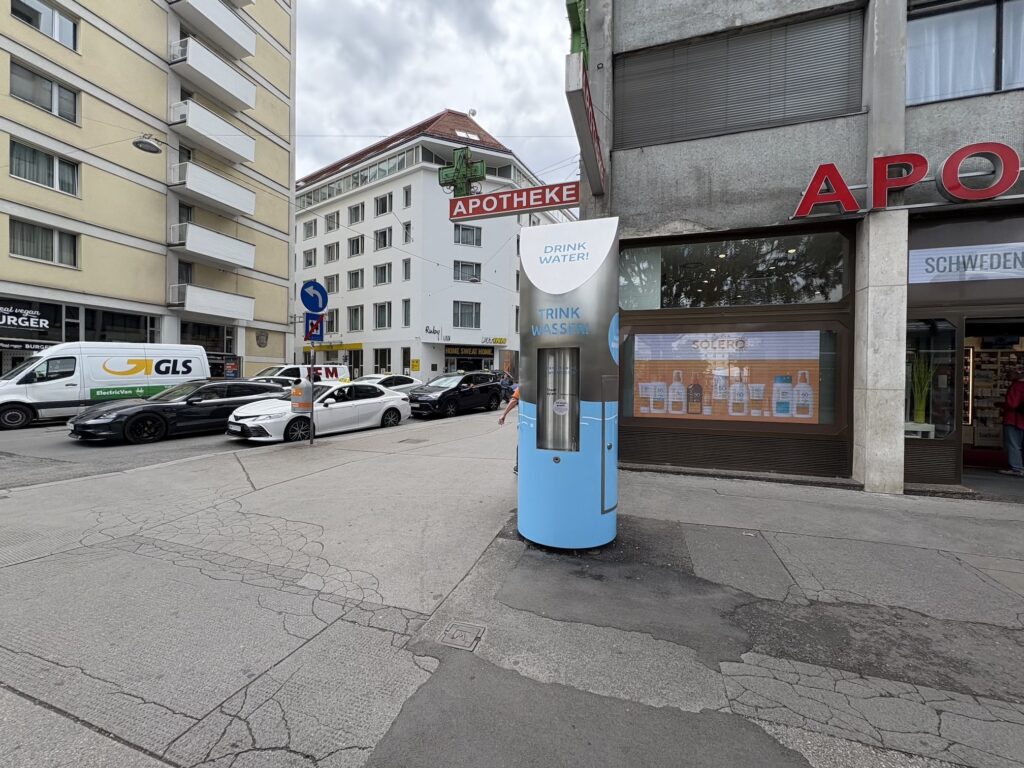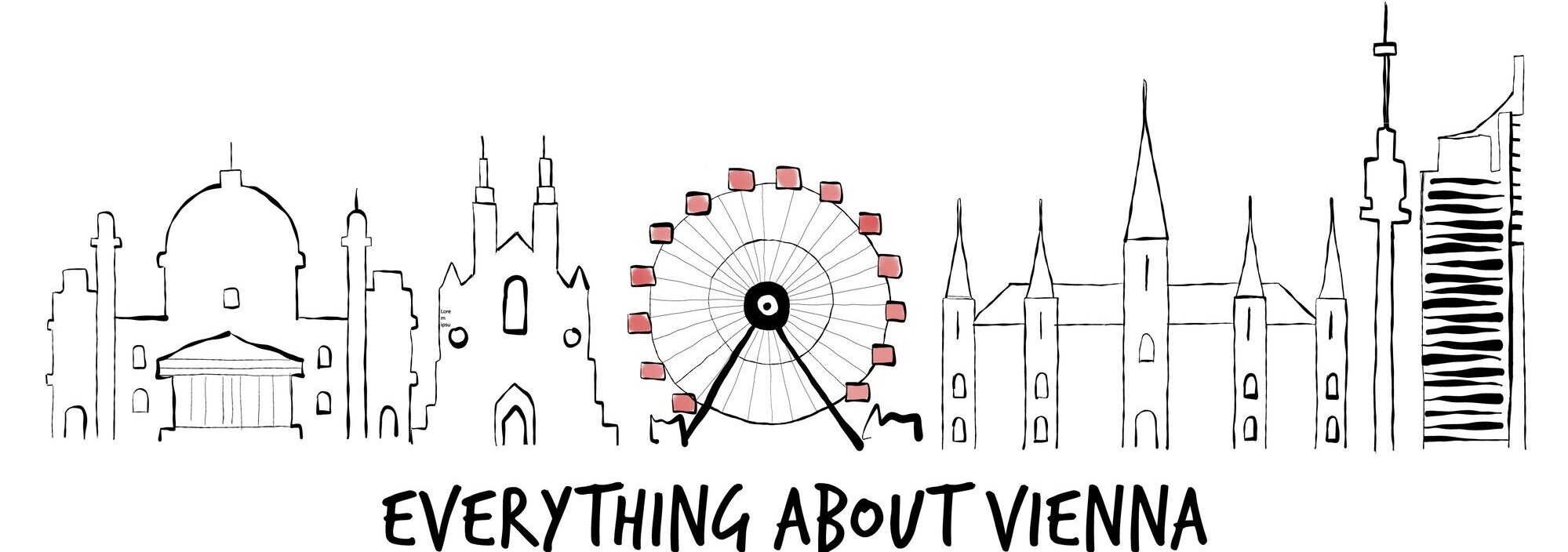On a hot summer day, you’re walking through Vienna’s historic centre. The sun reflects off the stone facades, and tourists gather around Stephansplatz. You pass a cast-iron drinking fountain tucked next to a quiet side street. With one hand on your refillable bottle and the other pressing the spout, you taste the water; cold, clean, and surprisingly fresh. It didn’t just come from a nearby reservoir. This water began its journey in the Austrian Alps.
Whether you’re here for two days or two weeks, you’ll notice how central water is to everyday life in Vienna. It flows through more than just taps and fountains,it’s part of the city’s identity, infrastructure, and even its pride. And as a visitor, it’s one of the simplest ways to experience the city like a local.
Can you drink tap water in Vienna?
Absolutely, and you should. Vienna’s tap water isn’t just safe to drink; it’s exceptional. Sourced directly from protected alpine springs, it arrives in your glass after travelling over 100 kilometres through high-altitude pipelines, untouched by pumps or industrial treatment. No chlorine. No filtering. Just pure mountain spring water, delivered fresh, cool, and full of natural minerals.
The quality is so high that many locals compare it to bottled water from premium brands, and often prefer it. Restaurants serve it without hesitation, and there’s no shame in asking for tap water with your meal. In fact, the city takes immense pride in its water system, which has been legally protected as part of Vienna’s commitment to public health and sustainability.
Look for signs that say “Trinkwasser” at fountains and public refill points, they mean the water is drinkable. If a fountain says “Kein Trinkwasser”, it’s decorative or non-potable, but those are clearly marked.
In a city known for imperial grandeur and classical music, it might seem strange to get excited about water. But once you’ve tasted it on a hot summer day, straight from the source, you’ll understand why Viennese tap water is something truly worth celebrating.
Local tip: Bring a reusable bottle when exploring the city, especially in summer. Vienna has over 1,000 public drinking fountains, many of them marked with “Trinkwasser” signs. Some even have built-in bottle fillers, perfect for staying hydrated without creating waste.
Where does Vienna’s tap water come from?
Vienna’s tap water doesn’t come from a nearby lake or underground reservoir. It begins its journey high in the Austrian Alps, over 100 kilometres away, and travels to the city through one of the most advanced gravity-fed pipeline systems in the world.
The two main pipelines, known as the First and second Vienna mountain spring pipelines (Hochquellenleitungen), were built in 1873 and 1910. They were engineering marvels of their time and are still in use today. The water flows entirely by gravity, meaning no pumps are used along the way, just clever planning and the natural downhill slope from mountain to city.
The springs that supply Vienna’s water lie in protected catchment areas in the Northern Limestone Alps, including regions in Styria and Lower Austria. These areas are carefully monitored to maintain the purity of the water, and construction or agriculture is heavily restricted to avoid contamination.
The result? Water that is fresh, clean, naturally cool and full of minerals straight from the mountains to your tap, with no additives or treatment needed.
Local tip: If you’re hiking in regions like Rax or Schneeberg, where Vienna’s water comes from, you might spot the original catchment structures. It’s a nice way to literally connect your walk with what’s in your glass back in the city.
Drinking fountains across the city

One of the best things about Vienna in warmer months? You’re never far from a free, fresh sip of mountain water. The city maintains over 1,000 public drinking fountains, many of which are beautifully designed and easy to find in parks, near playgrounds, at busy squares and along walking routes. You can find the nearest drinking fountain on a handy map.
Most fountains are active from spring through autumn, typically from April to October, depending on the weather. You’ll recognise them by the clear “Trinkwasser” signs, often in blue or stainless steel, and by the consistent stream of cold, clean water flowing from simple taps or stylised spouts.
Some newer fountains are equipped with bottle-filling stations, designed to help reduce plastic waste and support the city’s sustainability goals. Others take the form of classic iron pumps or sculptural designs integrated into public squares, blending practicality with visual charm.
Local tip: If you’re walking through the city and running low on water, check the Vienna city app or the website trinkbrunnen.at (in German) for an interactive map of public fountains. It’s updated regularly and helps you find the nearest place to refill.
Cooling stations and fog showers in summer
Vienna’s commitment to public comfort and climate adaptation becomes especially visible during the hotter months. When temperatures rise, the city activates a network of cooling stations and fog showers, simple but effective structures that offer welcome relief in parks, public squares, and busy pedestrian areas.
These cooling stations vary in form. Some release a fine mist through archways or upright poles, creating a brief, refreshing cloud of cool air. Others feature benches under shaded structures with water vapor systems, allowing people to sit and cool off without getting soaked. They’re especially popular with families, cyclists, and anyone spending time outdoors during a heatwave.
You’ll find these fog showers at strategic points around the city, including Mariahilfer Straße, MuseumsQuartier, and near major U-Bahn exits. They typically operate from June through September, depending on the weather forecast and air quality levels.
What makes these installations even better? They use the same high-quality mountain spring water that flows through the city’s taps, so it’s not only refreshing, but safe for kids and pets too.
Local tip: The cooling stations are a great reason to explore Vienna on foot, even in summer. Plan your route to pass by one or two, and you’ll be surprised how much more comfortable your city walk becomes.
Practical tips for visitors
Staying hydrated in Vienna is easy, but a few simple tips can make the experience even smoother, especially if you’re visiting in warmer months or planning to explore the city on foot.
Bring a refillable bottle
With over a thousand public drinking fountains and bottle-filling stations, there’s no need to rely on single-use plastics. Most locals carry a lightweight bottle and refill as they go. You’ll find bottles for sale in supermarkets, drug stores like the DM and Bipa and even souvenir shops if you didn’t pack one.
Look for the “Trinkwasser” sign
Any fountain or tap labeled “Trinkwasser” is safe to drink from. If you see “Kein Trinkwasser”, the water is not suitable for drinking, these are usually ornamental fountains or older fixtures in parks.
Water in restaurants
Tap water is commonly served in restaurants, but not always automatically. Don’t hesitate to ask for Leitungswasser (tap water) alongside your meal. Some places may charge a small fee, especially in more touristy areas, but this is not the norm.
Mind the seasons
Public fountains and cooling stations typically operate between April and October. In winter, many are turned off to prevent freezing. If you’re visiting outside of summer, your best bet for water refills is indoors, in museums, cafés or train stations.
Language note
Even if you don’t speak German, most signs are self-explanatory. But just in case:
- Trinkwasser = drinking water
- Kein Trinkwasser = not drinking water
Local tip: Some of the most charming refill spots are found just off the main tourist trails, in neighbourhood parks or small side streets. Don’t be afraid to stray a little from the guidebook path. Vienna rewards the curious.
Since 2025, a deposit system applies to plastic bottles in Austria. When you buy bottled drinks, you’ll pay a small deposit (Pfand), which you get back when returning the empty bottle at collection machines found in supermarkets and train stations. While the system helps reduce litter, bringing a reusable bottle remains the most eco-friendly option, especially in a city where tap water is this good.
A small act with a big impact
Refilling your bottle at one of Vienna’s public fountains may seem like a simple gesture, but it’s part of something bigger. By choosing tap water over bottled, you’re reducing plastic waste, cutting down on emissions, and tapping into a system that’s been designed with both people and the planet in mind.
Vienna’s water infrastructure is not only a technical achievement, but a symbol of how sustainability and daily life can go hand in hand. It’s clean, free, and available to everyone, whether you live here or are just passing through.
So the next time you pause at a quiet fountain in a leafy square or feel the mist from a fog shower on a hot afternoon, take a moment to enjoy what you’re really experiencing: one of the most refreshing examples of how urban living and environmental care can coexist.

